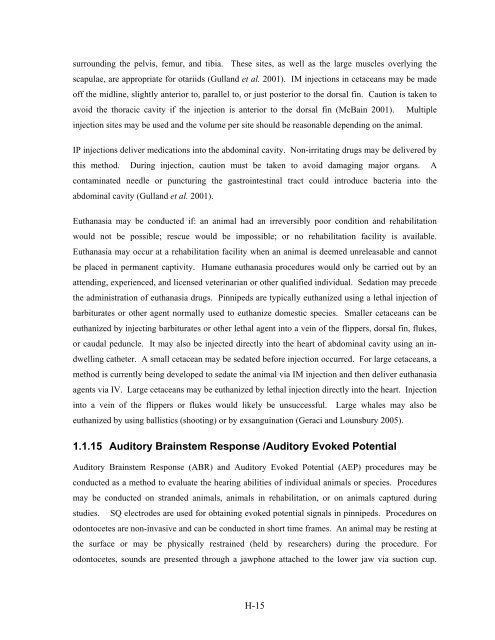Volume III, Appendices EM - National Marine Fisheries Service ...
Volume III, Appendices EM - National Marine Fisheries Service ...
Volume III, Appendices EM - National Marine Fisheries Service ...
You also want an ePaper? Increase the reach of your titles
YUMPU automatically turns print PDFs into web optimized ePapers that Google loves.
surrounding the pelvis, femur, and tibia. These sites, as well as the large muscles overlying the<br />
scapulae, are appropriate for otariids (Gulland et al. 2001). IM injections in cetaceans may be made<br />
off the midline, slightly anterior to, parallel to, or just posterior to the dorsal fin. Caution is taken to<br />
avoid the thoracic cavity if the injection is anterior to the dorsal fin (McBain 2001). Multiple<br />
injection sites may be used and the volume per site should be reasonable depending on the animal.<br />
IP injections deliver medications into the abdominal cavity. Non-irritating drugs may be delivered by<br />
this method. During injection, caution must be taken to avoid damaging major organs. A<br />
contaminated needle or puncturing the gastrointestinal tract could introduce bacteria into the<br />
abdominal cavity (Gulland et al. 2001).<br />
Euthanasia may be conducted if: an animal had an irreversibly poor condition and rehabilitation<br />
would not be possible; rescue would be impossible; or no rehabilitation facility is available.<br />
Euthanasia may occur at a rehabilitation facility when an animal is deemed unreleasable and cannot<br />
be placed in permanent captivity. Humane euthanasia procedures would only be carried out by an<br />
attending, experienced, and licensed veterinarian or other qualified individual. Sedation may precede<br />
the administration of euthanasia drugs. Pinnipeds are typically euthanized using a lethal injection of<br />
barbiturates or other agent normally used to euthanize domestic species. Smaller cetaceans can be<br />
euthanized by injecting barbiturates or other lethal agent into a vein of the flippers, dorsal fin, flukes,<br />
or caudal peduncle. It may also be injected directly into the heart of abdominal cavity using an indwelling<br />
catheter. A small cetacean may be sedated before injection occurred. For large cetaceans, a<br />
method is currently being developed to sedate the animal via IM injection and then deliver euthanasia<br />
agents via IV. Large cetaceans may be euthanized by lethal injection directly into the heart. Injection<br />
into a vein of the flippers or flukes would likely be unsuccessful. Large whales may also be<br />
euthanized by using ballistics (shooting) or by exsanguination (Geraci and Lounsbury 2005).<br />
1.1.15 Auditory Brainstem Response /Auditory Evoked Potential<br />
Auditory Brainstem Response (ABR) and Auditory Evoked Potential (AEP) procedures may be<br />
conducted as a method to evaluate the hearing abilities of individual animals or species. Procedures<br />
may be conducted on stranded animals, animals in rehabilitation, or on animals captured during<br />
studies. SQ electrodes are used for obtaining evoked potential signals in pinnipeds. Procedures on<br />
odontocetes are non-invasive and can be conducted in short time frames. An animal may be resting at<br />
the surface or may be physically restrained (held by researchers) during the procedure. For<br />
odontocetes, sounds are presented through a jawphone attached to the lower jaw via suction cup.<br />
H-15
















